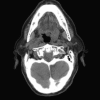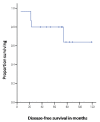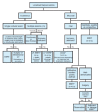Mucosal Kaposi sarcoma, a Rare Cancer Network study
- PMID: 23372913
- PMCID: PMC3557563
- DOI: 10.4081/rt.2012.e49
Mucosal Kaposi sarcoma, a Rare Cancer Network study
Abstract
Kaposi's sarcoma (KS) most often affect the skin but occasionally affect the mucosa of different anatomic sites. The management of mucosal KS is seldom described in the literature. Data from 15 eligible patients with mucosal KS treated between 1994 and 2008 in five institutions within three countries of the Rare Cancer Network group were collected. The inclusion criteria were as follows: age >16 years, confirmed pathological diagnosis, mucosal stages I and II, and a minimum of 6 months' follow-up after treatment. Head and neck sites were the most common (66%). Eleven cases were HIV-positive. CD4 counts correlated with disease stage. Twelve patients had biopsy only while three patients underwent local resection. Radiotherapy (RT) was delivered whatever their CD4 status was. Median total radiation dose was 16.2 Gy (0-45) delivered in median 17 days (0-40) with four patients receiving no RT. Six patients underwent chemotherapy and received from 1 to 11 cycles of various regimens namely vinblastin, caelyx, bleomycine, or interferon, whatever their CD4 counts was. Five-year disease free survival were 81.6% and 75.0% in patients undergoing RT or not, respectively. Median survival was 66.9 months. Radiation-induced toxicity was at worse grade 1-2 and was manageable whatever patients' HIV status. This small series of mucosal KSs revealed that relatively low-dose RT is overall safe and efficient in HIV-positive and negative patients. Since there are distant relapses either in multicentric cutaneous or visceral forms in head and neck cases, the role of systemic treatments may be worth investigations in addition to RT of localized disease. Surgery may be used for symptomatic lesions, with caution given the risk of bleeding.
Keywords: HIV; Kaposi sarcoma; classic.; head and neck; mucosal; radiation therapy; systemic treatment.
Conflict of interest statement
Conflict of interests: the authors report no conflict of interests.
Figures



Similar articles
-
Radiation therapy in the treatment of HIV-related Kaposi's sarcoma.Anticancer Res. 2013 May;33(5):2153-7. Anticancer Res. 2013. PMID: 23645769
-
Radiotherapy in the management of epidemic Kaposi's sarcoma.Int J Radiat Oncol Biol Phys. 1994 Dec 1;30(5):1207-11. doi: 10.1016/0360-3016(94)90330-1. Int J Radiat Oncol Biol Phys. 1994. PMID: 7525519
-
Preoperative hyperfractionated chemoradiation for locally recurrent rectal cancer in patients previously irradiated to the pelvis: A multicentric phase II study.Int J Radiat Oncol Biol Phys. 2006 Mar 15;64(4):1129-39. doi: 10.1016/j.ijrobp.2005.09.017. Epub 2006 Jan 18. Int J Radiat Oncol Biol Phys. 2006. PMID: 16414206 Clinical Trial.
-
Kaposi's sarcoma: a reevaluation.Recent Results Cancer Res. 1995;139:275-96. Recent Results Cancer Res. 1995. PMID: 7541146 Review.
-
A risk and benefit assessment of treatment for AIDS-related Kaposi's sarcoma.Drug Saf. 1999 May;20(5):403-25. doi: 10.2165/00002018-199920050-00002. Drug Saf. 1999. PMID: 10348092 Review.
Cited by
-
Role of Radiotherapy in Mucosal Kaposi Sarcoma.J Maxillofac Oral Surg. 2018 Mar;17(1):115-116. doi: 10.1007/s12663-017-1009-8. Epub 2017 Mar 31. J Maxillofac Oral Surg. 2018. PMID: 29383006 Free PMC article. No abstract available.
-
Primary Sarcomas of the Larynx: A Clinicopathologic Study of 27 Cases.Head Neck Pathol. 2021 Sep;15(3):905-916. doi: 10.1007/s12105-021-01314-8. Epub 2021 Mar 8. Head Neck Pathol. 2021. PMID: 33686585 Free PMC article.
-
Head and Neck Kaposi Sarcoma: Clinicopathological Analysis of 11 Cases.Head Neck Pathol. 2018 Dec;12(4):511-516. doi: 10.1007/s12105-018-0902-x. Epub 2018 Mar 5. Head Neck Pathol. 2018. PMID: 29508130 Free PMC article.
References
-
- Patrikidou A, Vahtsevanos K, Charalambidou M, et al. Non-AIDS Kaposi's sarcoma in the head and neck area. Head Neck. 2009;31:260–8. - PubMed
-
- Iscovich J, Boffetta P, Franceschi S, et al. Classic kaposi sarcoma: epidemiology and risk factors. Cancer. 2000;88:500–17. - PubMed
-
- Di Lorenzo G. Update on classic Kaposi sarcoma therapy: new look at an old disease. Crit Rev Oncol Hematol. 2008;68:242–9. - PubMed
-
- Schwartz RA, Micali G, Nasca MR, Scuderi L. Kaposi sarcoma: a continuing conundrum. J Am Acad Dermatol. 2008;59:179–206. quiz 207–8. - PubMed
LinkOut - more resources
Full Text Sources
Research Materials

